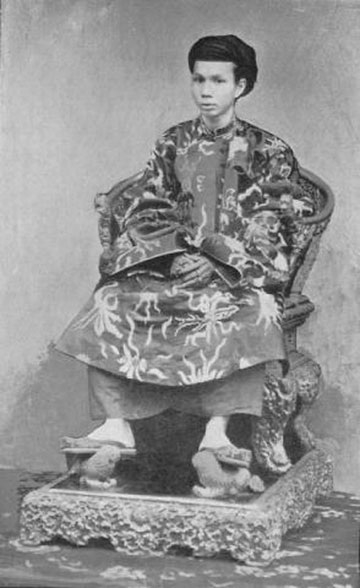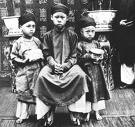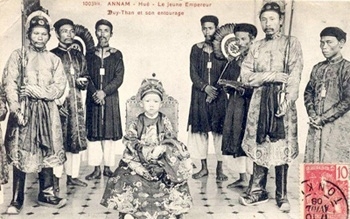>>Part 1: Paris, my two worlds
>>Part 2: A journey in search of freedom
>>Part 3: Nguyen the Patriot
>>Part 4: Indochina and little emperors
>>Part 5: The rise of patriotism
>>Part 6: Finding a compass
>>Part 7: Young Ho Chi Minh with Grand Chef Escoffier
>>Part 8: Young Ho Chi Minh in America
While French imperialism was in full expansion, Napoleon III authorized the invasion of Viet Nam.
 |
|
| Emperor Ham Nghi (age 12) | |
 |
|
| Emperor Thanh Thai (age 10) and his younger brothers | |
 |
|
| Emperor Duy Tan (age 7) |
In the summer of 1858, the French warship Catinat arrived in Da Nang. Their naval squadron set fire and destroyed the town. Bishop Pelerin proposed an attack on the Red River delta. He thought the assistance and loyalty of 400,000 converted-Catholic Vietnamese would assure a victory for France. Ignoring Pelerin’s advice, the commander immediately moved troops to the South.
The royal court in Hue did not order a counter-attack as it was seeking a compromise through diplomatic negotiation. However, the French continued with their violence and further conquests, dishonoring all treaties and concessions. The Imperial Palace soon fell to the hands of European aggression.
French troops attacked Sai Gon one night in February 1859. With their long-range weapons and naval forces operating in the Far East, they defeated royal troops and took over the city in 1860. The following year they gained complete control of all six provinces in the South.
In Can Tho, where my ancestors had lived, people became refugees overnight as French troops burned houses, killed the buffaloes, and destroyed the residents’ rice storages. Most of the land for growing rice and fruits that belonged to tiểu điền chủ (small landowners) were confiscated during the invasion. By 1939, more than half of the peasant population had been left landless, with 5% of the population owning 45% of the land. There was the new class of đại điền chủ (major landowners) with considerable power. The colonialists also obtained ownership of land in the South.
France gave the name “Cochinchina” to South Viet Nam in 1879 – making it their “Colony”. To strengthen their rule, colonial troops repeated their assaults on Sai Gon and Ha Noi with powerful artillery. Vietnamese generals, ill equipped for modern warfare, committed suicide to avoid being captured and executed. The entire North and Central Viet Nam, as well as Cambodia and Laos, became France’s “Protectorates” from 1883. Indochina was born.
The French enthroned Ham Nghi, age 12, in 1884. The young emperor was in favor of an armed uprising led by his senior mandarins. Being informed by spies, General De Courcy arrived at the Imperial Palace in 1885 and demanded the disbanding of the Vietnamese army. Emperor Ham Nghi fled to the remote mountains with his advisors and royal troops. The angry Vietnamese staged a national uprising known as the Can Vuong (Save The Emperor). Captured by colonial troops three years later, Ham Nghi was sent into exile in Algeria. The French had by then already installed Dong Khanh, as a puppet emperor.
Between 1886 and 1887 severe fighting took place at the fortress of Ba Dinh in Thanh Hoa, a stronghold of the Can Vuong’s army. French missionaries mobilized converted- Catholic Vietnamese in Phat Diem to aid French troops. The combined force shelled artillery at Ba Dinh for 35 consecutive days. After the fall of Ba Dinh, colonial troops conquered all pockets of resistance in the Red River delta.
Dong Khanh died in 1889 and the French chose Thanh Thai, age 10, to be the next emperor. When Thanh Thai got involved in plotting against the French, he was sent into exile in the Indian Ocean. The French replaced him with Duy Tan, age 7. In 1916, Emperor Duy Tan called for an uprising and was sent into exile in Reunion. Khai Dinh was enthroned and he would yield to all France’s demands.
By 1900, South Viet Nam was considered the “Pearl of the Far East” and the main source of wealth for a new commercial class of Europeans, Vietnamese collaborators, and ethnic Chinese. Most of the profits came from rubber plantations and rice cultivation. Two decades later Cochinchina became the world’s third largest rice exporter. Sai Gon became the main industrial and commercial centre of Indochina. While the colonial regime was making Sai Gon a fashionable city with French style buildings and tree-lined avenues, more land was confiscated. The Vietnamese were pushed away to set up slums along the canal of Ben Nghe and the outskirts of the city.

Leave your comment on this story